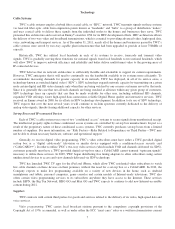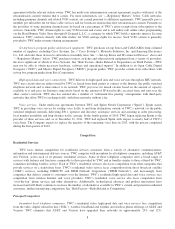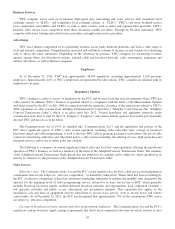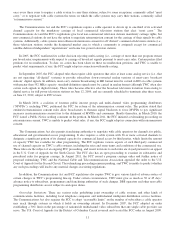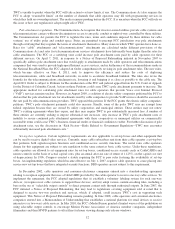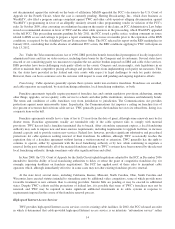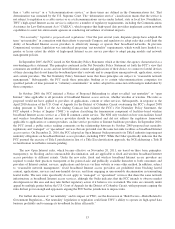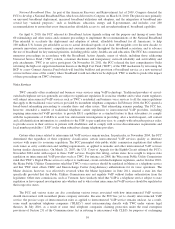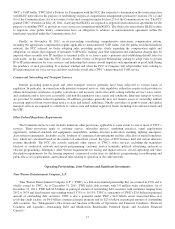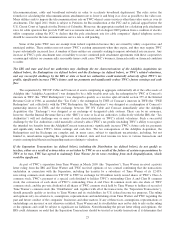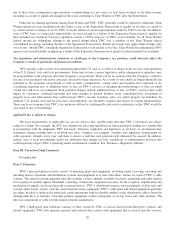Time Warner Cable 2011 Annual Report Download - page 24
Download and view the complete annual report
Please find page 24 of the 2011 Time Warner Cable annual report below. You can navigate through the pages in the report by either clicking on the pages listed below, or by using the keyword search tool below to find specific information within the annual report.National Broadband Plan. As part of the American Recovery and Reinvestment Act of 2009, Congress directed the
FCC to develop a National Broadband Plan, which was delivered to Congress on March 16, 2010. The plan focuses primarily
on universal broadband deployment, increased broadband utilization and adoption, and the integration of broadband into
several key “national purposes,” such as healthcare, education, energy and E-government, and includes over 200
recommendations to ensure that every American has affordable access to, and an understanding of, broadband capability.
On April 6, 2010, the FCC released its Broadband Action Agenda setting out the purpose and timing of more than
60 rulemakings and other notice-and-comment proceedings to implement the recommendations of the National Broadband
Plan intended to accelerate the deployment and adoption of robust, affordable broadband for all Americans; to help
100 million U.S. homes get affordable access to actual download speeds of at least 100 megabits over the next decade; to
promote innovation, investment, competition and consumer interests throughout the broadband ecosystem; and to advance
the use of broadband for key national priorities, including public safety, health care and education. The FCC has commenced
numerous proceedings in accordance with the Broadband Action Agenda, many of which, including those addressing
Universal Service Fund (“USF”) reform, consumer disclosure and transparency, network reliability and survivability and
pole attachments, TWC is an active participant. On November 18, 2011, the FCC released the first comprehensive Order
reforming the high cost support mechanism known as the High Cost Fund (“HCF”) of the USF mechanism by refocusing the
HCF to a new Connect America Fund which will fund the buildout and provision of broadband service as a new universal
service in those areas of the country where broadband would not otherwise be deployed. TWC is unable to predict the impact
of these proceedings on TWC’s business.
Voice Services
TWC currently offers residential and business voice services using VoIP technology. Traditional providers of circuit-
switched telephone services generally are subject to significant regulation. It is unclear whether and to what extent regulators
will subject interconnected VoIP services such as TWC’s residential and business voice services to all the same regulations
that apply to the traditional voice services provided by incumbent telephone companies. In February 2004, the FCC opened a
broad-based rulemaking proceeding to consider these and other issues. That rulemaking remains pending. The FCC has,
however, extended a number of traditional telephone carrier regulations to interconnected VoIP providers, including
requiring interconnected VoIP providers: to provide E911 capabilities as a standard feature to their subscribers; to comply
with the requirements of CALEA to assist law enforcement investigations in providing, after a lawful request, call content
and call identification information; to contribute to the USF; to pay regulatory fees; to comply with subscriber privacy rules;
to provide access to their services to persons with disabilities; and to comply with service discontinuance requirements and
local number portability (“LNP”) rules when subscribers change telephone providers.
Certain other issues related to interconnected VoIP services remain unclear. In particular, in November 2004, the FCC
determined that regardless of their regulatory classification, certain interconnected VoIP services qualify as interstate
services with respect to economic regulation. The FCC preempted state public utility commission regulations that address
such issues as entry certification and tariffing requirements, as applied to nomadic and other interconnected VoIP services
having similar characteristics. On March 21, 2007, the U.S. Court of Appeals for the Eighth Circuit affirmed the FCC’s
November 2004 order with respect to these VoIP services. Despite this ruling, certain states have sought to impose state
regulation on interconnected VoIP providers such as TWC. For instance, in 2008, the Wisconsin Public Utility Commission
ruled that TWC’s Digital Phone service is subject to traditional, circuit-switched telephone regulation, and in October 2010,
the Maine Public Utilities Commission ruled that TWC’s voice services should be regulated in Maine as a telephone service
and that TWC must obtain CLEC and Interexchange Carrier (long-distance) authorizations for its voice operations. The
Maine decision, however, was effectively reversed when the Maine legislature, in June 2011, enacted a state law that
specifically provided that the Public Utilities Commission may not regulate VoIP without further authorization from the
legislature. Other state commissions, such as Vermont, have similarly ruled that VoIP is a telephone service subject to state
regulation or have opened investigations into whether and to what extent interconnected VoIP services should be regulated in
their respective states.
The FCC and various states are also considering various issues associated with how interconnected VoIP services
should interconnect with incumbent phone company networks. Because the FCC has yet to classify interconnected VoIP
service, the precise scope of interconnection rules as applied to interconnected VoIP service remains unclear. As a result,
some small incumbent telephone companies (“RLECs”) resist interconnecting directly with TWC under various legal
theories. In July 2010, as a result of some rural telephone companies claiming protection under the rural exemption
provisions of Section 251 of the Communications Act in refusing to interconnect with CLECs for purposes of exchanging
16



